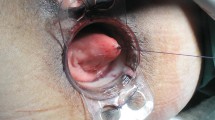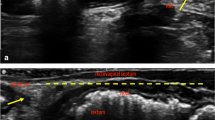Abstract
Obstructed defaecation in the descending perineum syndrome has been attributed to anterior mucosal prolapse. Manometric and radiological measurements together with evacuation proctograms in 49 patients with obstructed defaecation and normal whole gut transit times were carried out and compared in a total of 25 controls. Proctography delineated four groups: (I) puborectalis accentuation,n=11; (II) rectal intussusception,n=25; (III) anterior rectal wall prolapse,n=11; (IV) rectocele,n=2. The anorectal angle at rest, maximum basal sphincter pressures and the rectoanal inhibitory reflex did not differ between the groups and controls. Group III achieved a greater increase in anorectal angle on straining than controls. Groups II and III exhibited significant perineal descent below the pubococcygeal line whereas group I did not. In perineal descent intussusception was the commonest morphological abnormality associated with obstructed defaecation. Isolated anterior mucosal prolapse was not observed, making local treatment aimed at reducing its bulk questionable.
Similar content being viewed by others
References
Parks AG, Porter NH, Hardcastle J (1966) The syndrome of the descending perineum. Proc R Soc Med 59:477–482
Rutter KRP (1974) Electromyographic changes in certain pelvic floor abnormalities. Proc R Soc Med 67:53–56
Rutter KRP (1985) Solitary ulcer syndrome of the rectum: its relation to mucosal prolapse. In: Henry MM, Swash M (eds) Coloproctology and the Pelvic Floor. Pathophysiology and Management. Butterworths, London
Ihre T, Seligson U (1975) Intussusception of the rectum —internal procidentia: treatment and results in 90 patients. Dis Colon Rectum 18:391–396
Frenckner B, Ihre T (1976) Function of the anal sphincters in patients with intussusception of the rectum. Gut 17:147–151
Broden B, Snellman B (1968) Procidentia of the rectum. Studies with cineradiography. Dis Colon Rectum 11:330–347
Bartolo DCC, Roe AM, Virjee J, Mortensen NJMcC (1985) Evacuation proctography in obstructed defaecation and rectal intussusception. Br J Surg 72 [Suppl]: 111–116
Henry MM (1985) Descending perineum syndrome. In: Henry MM, Swash M (eds) Coloproctology and the pelvic floor. Pathophysiology and management. Butterworths, London
Hinton JM, Lennard-Jones J, Young AC (1969) A new method for studying gut transit times using radio opaque markers. Gut 10:842–847
Duthie HL, Watts JM (1965) Contribution of the external anal sphincter to the pressure zone in the anal canal. Gut 6:64–68
Schuster MM, Hendrix TR, Mendeloff AI (1963) The internal sphincter response: manometric studies on its normal physiology, neural pathways and alteration in bowel disorders. J Clin Invest 42:196–207
Read MG, Read NW, Barber DC, Duthie HL (1982) Dig Dis Sci 27:807–814
Bartolo DCC, Read NW, Jarratt JA, Read MG, Donnelly TC, Johnson AG (1983) Differences in anal sphincter function and clinical presentation in patients with pelvic floor descent. Gastroenterology 86:68–75
Du Boulay CE, Fairbrother J, Isaacson PG (1983) Mucosal prolapse syndrome —unifying concept for solitary ulcer syndrome and related disorders. J Clin Pathol 36:1264–1268
Mahieu P, Pringot J, Bodart P (1985) Defecography: II. Contribution to the diagnosis of defecation disorders. Gastrointest Radiol 9:253–261
Snooks SJ, Nicholls RJ, Henry MM, Swash M (1985) Electrophysiological and manometric assessment of the pelvic floor in the solitary rectal ulcer syndrome. Br J Surg 72:131–133
Womack NR, Williams NS, Holmfield JHM, Morrison JFB, Simpkins KC (1985) New method for the dynamic assessment of anorectal function in constipation. Br J Surg 72:994–998
Kuijpers JHK, Strijk SP (1984) Diagnosis of disturbances of continence and defaecation. Dis Colon Rectum 27:658–672
Kuipers HC, Bleijenberg G (1985) The spastic pelvic floor syndrome, a cause of constipation. Dis Colon Rectum 20:669–672
Kuijpers HC, Bleijenberg G, de Morree H (1986) The spastic pelvic floor syndrome. Int J Colorect Dis 1:44–48
Author information
Authors and Affiliations
Rights and permissions
About this article
Cite this article
Bartolo, D.C.C., Roe, A.M., Virjee, J. et al. An analysis of rectal morphology in obstructed defaecation. Int J Colorect Dis 3, 17–22 (1988). https://doi.org/10.1007/BF01649677
Accepted:
Issue Date:
DOI: https://doi.org/10.1007/BF01649677




